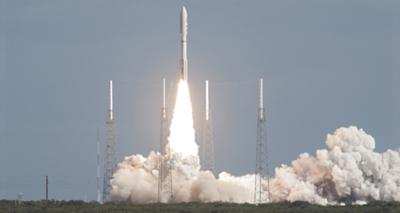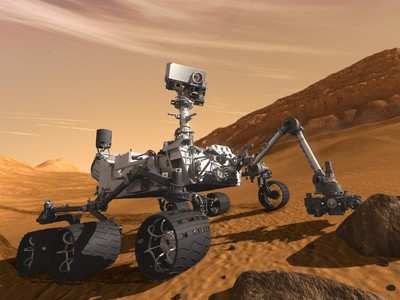Fri, Dec 16, 2011
Monitoring Radiation During Eight-Month Passage To Mars
NASA's car-sized Curiosity rover has begun monitoring space
radiation during its 8-month trip from Earth to Mars. The research
will aid in planning for future human missions to the Red Planet.
Curiosity launched on November 26 from Cape Canaveral, FL., aboard
the Mars Science Laboratory (MSL). The rover carries an instrument
called the Radiation Assessment Detector (RAD) that monitors
high-energy atomic and subatomic particles from the sun, distant
supernovas and other sources.

These particles constitute radiation that could be harmful to
any microbes or astronauts in space or on Mars. The rover also will
monitor radiation on the surface of Mars after its August 2012
landing. "RAD is serving as a proxy for an astronaut inside a
spacecraft on the way to Mars," said Don Hassler, RAD's principal
investigator from the Southwest Research Institute in Boulder,
Colo. "The instrument is deep inside the spacecraft, the way an
astronaut would be. Understanding the effects of the spacecraft on
the radiation field will be valuable in designing craft for
astronauts to travel to Mars."
Previous monitoring of energetic-particle radiation in space has
used instruments at or near the surface of various spacecraft. The
RAD instrument is on the rover inside the spacecraft and shielded
by other components of MSL, including the aeroshell that will
protect the rover during descent through the upper atmosphere of
Mars.

Spacecraft structures, while providing shielding, also can
contribute to secondary particles generated when high-energy
particles strike the spacecraft. In some circumstances, secondary
particles could be more hazardous than primary ones. These first
measurements mark the start of the science return from a mission
that will use 10 instruments on Curiosity to assess whether Mars'
Gale Crater could be or has been favorable for microbial life.
"While Curiosity will not look for signs of life on Mars, what it
might find could be a game- changer about the origin and evolution
of life on Earth and elsewhere in the universe," said Doug
McCuistion, director of the Mars Exploration Program at NASA
Headquarters in Washington. "One thing is certain: the rover's
discoveries will provide critical data that will impact human and
robotic planning and research for decades."
As of noon EST on Dec. 14, the spacecraft had traveled 31.9
million miles of its 352-million-mile flight to Mars. The
first trajectory correction maneuver during the trip is being
planned for mid-January. (Images Courtesy NASA)
More News
Homing [ICAO] The procedure of using the direction-finding equipment of one radio station with the emission of another radio station, where at least one of the stations is mobile, >[...]
Aero Linx: European Regions Airline Association (ERA) The European Regions Airline Association (ERA) represents a diverse membership of over 50 airlines and more than 150 associate>[...]
A Few Questions AND Answers To Help You Get MORE Out of ANN! 1) I forgot my password. How do I find it? 1) Easy... click here and give us your e-mail address--we'll send it to you >[...]
While On Short Final, About 300 Ft, The Pilot Performed A Forced Landing Near Trees On September 7, 2025, about 0932 eastern daylight time, a CubCrafters Carbon Cub EX airplane, N4>[...]
Severe Icing The rate of ice accumulation is such that ice protection systems fail to remove the accumulation of ice and ice accumulates in locations not normally prone to icing, s>[...]
 ANN's Daily Aero-Term (10.13.25): Homing [ICAO]
ANN's Daily Aero-Term (10.13.25): Homing [ICAO] ANN's Daily Aero-Linx (10.13.25)
ANN's Daily Aero-Linx (10.13.25) ANN FAQ: Q&A 101
ANN FAQ: Q&A 101 NTSB Prelim: CubCrafters Carbon Cub
NTSB Prelim: CubCrafters Carbon Cub ANN's Daily Aero-Term (10.14.25): Severe Icing
ANN's Daily Aero-Term (10.14.25): Severe Icing




